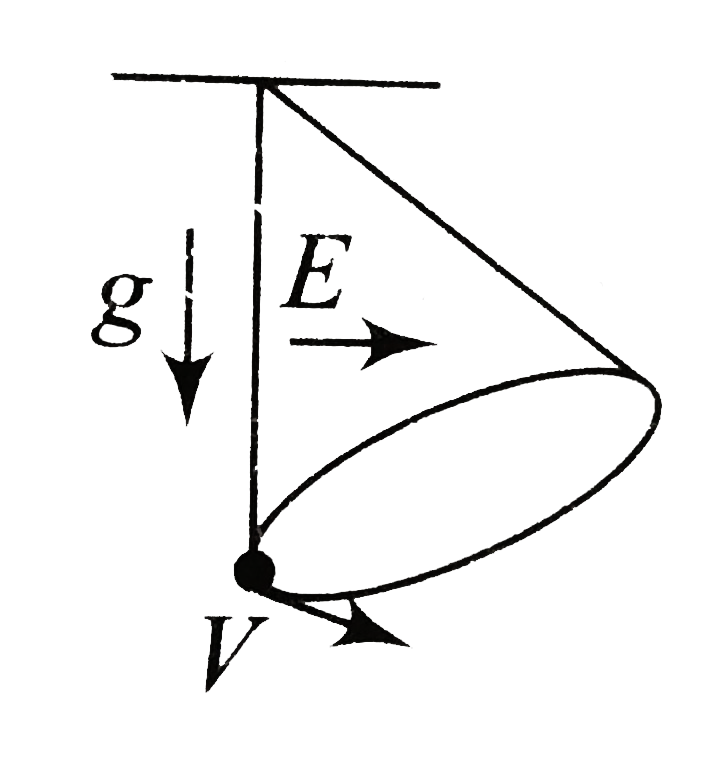A Charged particle of mass 1.0 g is suspended through a
. silk thread of length 40 cm in a horizantal electric field
. of 4.0×104NC−1 . If the particle stays aty a distance of
. 24 cm from the wall in equilibrium, find the charge on
. the particle.
To solve the problem step by step, we will analyze the forces acting on the charged particle suspended by a silk thread in a horizontal electric field.
Step 1: Understanding the Setup
We have a charged particle of mass m=1.0g=1.0×10−3kg suspended by a silk thread of length L=40cm=0.4m. The particle is in a horizontal electric field E=4.0×104N/C and is at a distance of d=24cm=0.24m from the wall.
Step 2: Finding the Angle θ
The horizontal distance from the wall to the particle is d=0.24m, and the length of the thread is L=0.4m. We can find the vertical distance h from the wall to the particle using the Pythagorean theorem:
h=√L2−d2=√(0.4)2−(0.24)2
Calculating h:
h=√0.16−0.0576=√0.1024=0.32m
Now we can find θ:
cosθ=dL=0.240.4=0.6
sinθ=√1−cos2θ=√1−(0.6)2=√0.64=0.8
Step 3: Setting Up Force Equations
In equilibrium, the forces acting on the particle can be balanced as follows:
1. The vertical components:
Tcosθ=mg
2. The horizontal components:
Tsinθ=qE
Step 4: Calculate the Tension T
From the vertical component equation:
Tcosθ=mg
Substituting the values:
T(0.6)=(1.0×10−3kg)(9.8m/s2)
T(0.6)=9.8×10−3
T=9.8×10−30.6=0.01633N
Step 5: Calculate the Charge q
Now we can substitute T into the horizontal force equation:
Tsinθ=qE
Substituting the known values:
(0.01633)(0.8)=q(4.0×104)
Calculating the left side:
0.013064=q(4.0×104)
Now solve for q:
q=0.0130644.0×104=3.266×10−7C
Final Answer
The charge on the particle is approximately:
q≈3.27×10−7C
We have a charged particle of mass m=1.0g=1.0×10−3kg suspended by a silk thread of length L=40cm=0.4m. The particle is in a horizontal electric field E=4.0×104N/C and is at a distance of d=24cm=0.24m from the wall.
The horizontal distance from the wall to the particle is d=0.24m, and the length of the thread is L=0.4m. We can find the vertical distance h from the wall to the particle using the Pythagorean theorem:
In equilibrium, the forces acting on the particle can be balanced as follows:
Tcosθ=mg
Tsinθ=qE
From the vertical component equation:
Substituting the values:
Now we can substitute T into the horizontal force equation:
The charge on the particle is approximately:
Topper's Solved these Questions
- ELECTRIC FIELD AND POTENTIALBOOK - HC VERMA ENGLISHCHAPTER - ELECTRIC FIELD AND POTENTIALEXERCISE - Exercises
75 Videos
- ELECTRIC FIELD AND POTENTIALBOOK - HC VERMA ENGLISHCHAPTER - ELECTRIC FIELD AND POTENTIALEXERCISE - question for short answer
14 Videos
- ELECTRIC FIELD AND POTENTIALBOOK - HC VERMA ENGLISHCHAPTER - ELECTRIC FIELD AND POTENTIALEXERCISE - Objective 2
7 Videos
- ELECTRIC CURRENT THROUGH GASESBOOK - HC VERMA ENGLISHCHAPTER - ELECTRIC CURRENT THROUGH GASESEXERCISE - Short answer
6 Videos
- ELECTROMAGNETIC INDUCTIONBOOK - HC VERMA ENGLISHCHAPTER - ELECTROMAGNETIC INDUCTIONEXERCISE - Questions for short answer
9 Videos
Similar Questions
A vertical electric field of magnitude 4.00×105NC−1. just prevents a water droplet of mass 1.000×10−4kgfrom. falling., find the charge on the droplet.
View SolutionA positively charged particle of charge q and mass m is suspended from a point by a string of length l. In the space a uniform horizontal electric field E exists . The particle is drawn aside so that it is projected horizontally with velocity v such that the particle starts to move along a circle with same constant speed v. Find the speed v.

View Solution
Knowledge Check
A particle of mass 10−3kg and charge 5μC is thrown at a speed of 20ms−1 against a uniform electric field of strength 2×105NC−1. The distance travelled by particle before coming to rest is
A0.1 mB0.2 mC0.3 mD0.4 m
A particle of mass m=0.1kg and having positive charge q=75μC is suspended from a point by a thread of length l=10cm. In the space, a uniform horizontal electric field E=104NC−1 exists. The particle is drawn aside so that the thread becomes vertical and then it is projected horizontally with velocity v such that the particle starts to move along a circle with the same constant speed V. Calculate the radius of the circle and speed v(g=10ms−2).
View SolutionA charged particle of mass 5×10−5kg is held stationary in space by placing it in an electric field of strength 107NC−1 directed vertically downwards. The charge on the particle is
View SolutionA charged particle of mass m and charge q is released from rest in an electric field of constant magnitude E. The kinetic energy of the particle after time t is
View SolutionA charged particle of mass m and charge q is released from rest the position (x0,0) in a uniform electric field E0ˆj. The angular momentum of the particle about origin.
View SolutionA particle of mass 1 g and charge 2.5×10−4C is released from rest in an electric field of 1.2×104NC−1 (a) Find the electric force and the force of gravity acting on this particle. Can one of these forces be neglected in comparison with the other for approximate analysis? (b) How long will it take for the particle to travel a distance of 40 cm? (c) What will be the speed of the particle after travelling this destance? (d) how much is the work done by electric force on the particle during this period?
View SolutionAn electric dipole consists of charges ±2.0×108C separated by a distance of 2.0×10−3 m. It is placed near a long ilne charge of linear charge density 4.0×10−4Cm−1 as shown in figure (30-W4), Such thet the negative charge is at a distance of 2.0 cm from the line charge. Find the force acting on the dipole.

View SolutionAn electric dipole consists of charges ±2.0×10−8C separated by a distance of 2.0×10−3 m. It is placed near a long line charge of linear charge density 4.0×10−4Cm−1 as shown in figure (30-W4), Such that the negative charge is at a distance of 2.0 cm from the line charge. Find the force acting on the dipole.

View Solution
